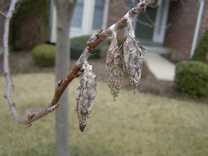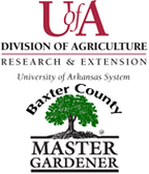|
Ozark Green Thumb BCMG Monthly e-Newsletter |
|
|
 Close-up of bagworms (Lepidoptera) on magnolia (Magnolia) Picture from Missouri Botanical Gardens Close-up of bagworms (Lepidoptera) on magnolia (Magnolia) Picture from Missouri Botanical Gardens Bagworms, Thyridopteryx ephemeraeformis, produce conspicuous spindle-shaped cocoons on trees and shrubs throughout the United States. Bagworms feed on over 128 plant species. The most commonly attacked plants are arborvitae, red cedar, and other juniper species. They will also feed on fir, maple, juneberry, buckeye, persimmon, ginkgo, honeylocust, larch, sweet gum, spruce, pine, sycamore, poplar, oak, locust, willow, and hemlock. Symptoms and Diagnosis The principle harm done by the insect is the destruction of foliage by the caterpillars. Plants usually are partially defoliated, weakened, and rendered unsightly. Complete defoliation can occur. The most notable sign of bagworm infestation is the presence of protective bags attached to a branch. The bags incorporate bits of twigs and leaves from the host plant. They are approximately 1 to 2 inches long and resemble Christmas tree ornaments hanging from the limbs. Life Cycle The adult female bagworm does not look like a moth and never leaves her bag. She is maggot-like in appearance, soft-bodied, and yellowish-white. A mated female lays between 500 and 1000 eggs within the bag, after which she dies. The eggs remain inside the bag throughout the winter until they hatch the following spring. There is one generation a year. From late May to mid-June, bagworm larvae (caterpillars) begin emerging from the bags. Almost immediately after emerging, a larva starts to produce its own protective bag. The bag is constructed such that the larva's head and legs are free. This construction allows the larvae to move about the plant as it feeds on the foliage. As the larva grows, it increases the size of its bag. The full-grown larvae are about one inch long. When a host plant becomes defoliated, the larvae will crawl off it with their bags and search for a new plant to feed upon. In mid-August, the mature larvae stop feeding and attach their bags to a twig. They close up the bag and pupate. By mid-September, the bagworm has completed its development, and adult males begin emerging from their bags. The male moth has a black, furry body and feathery antennae. The wings are almost transparent and have a span of about one inch. Integrated Pest Management Strategies 1. Handpick the bags. The most economical method of controlling bagworms is to handpick the bags and destroy them. Some birds and insect predators feed on larvae, so light infestations on large, healthy plants are usually controlled by natural means. On large plants, monitor infestations before resorting to chemical sprays. If the problem doesn't get worse, spraying is not required. 2. Use biological controls. In spring, as soon as eggs hatch and the young emerge, spray with Bacillus thuringiensis (Bt). Bt is a bacterium that causes the larvae to become sick, stop feeding, and later die. In St. Louis, the eggs hatch in late May to mid-June, or about the time the cigar tree, Catalpa speciosa, is in full bloom. 3. Use chemical controls. Because bagworms form protective bags very early, contact insecticides, while useful, are less effective than stomach poisons. For best control, spray when insects are young. Chemical controls become less effective as the bagworm matures. Chemical controls include acephate (Orthene), cyfluthrin and spinosad. Source: Missouri Botanical Garden
0 Comments
Leave a Reply. |
Archives
April 2022
|
|
